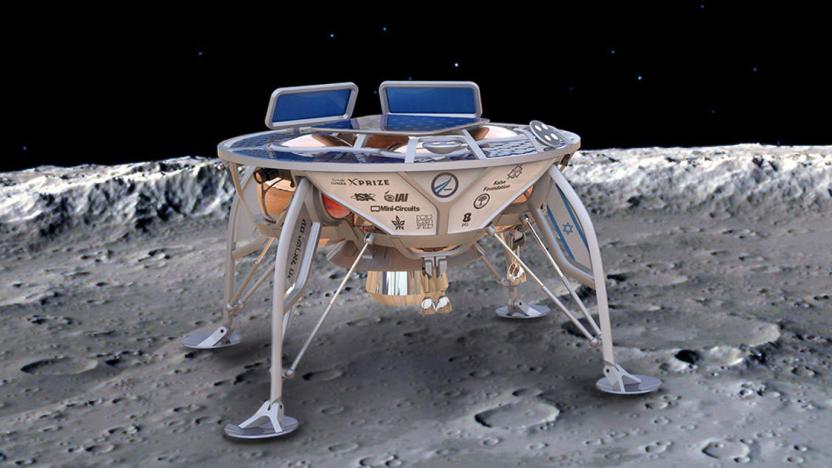lunarxprize
Latest

After Math: If I had no loot
It was a week of lost and found fortunes in the tech world. The Feds charged My Big Coin Pay over its $6 million cryptocurrency scam, Netflix is poised to take home as many a four golden statues for Mudbound, Bungie's in hot water again over tweaking its Faction token payouts and Google will be holding onto its $20 million XPrize payout thankyouverymuch. Numbers, because how else would you evenly divvy up the spoils?

Google's $20 million Lunar Xprize will end without a winner
The Lunar Xprize is about to come to an anticlimactic end after more than a decade. Google has confirmed to CNBC that it doesn't plan to extend the $20 million competition past its March 31st deadline -- itself an extension well beyond the original 2014 end date. Given that all the finalists either don't have the funds to continue or don't expect to launch that quickly (the fastest, SpaceIL, might not launch before the end of 2018), the competition is effectively over with no winners. Not that Google minds, however.

Google offers Lunar Xprize finalists an extra $4.75 million
It's been almost 10 years since Google and Xprize launched their lunar spacecraft challenge, and they're giving the final contenders more incentive to cross the finish line. The partners are fattening up their Milestone Prize purse with an extra $4.75 million "to recognize the full gravity of these bold technological feats taking place in the race to the moon."

Moon Express details plans to mine the moon with robots by 2020
Spaceflight company Moon Express has released its plans to mine the moon with robots and it aims to get started by 2020. The company was founded in 2010 with the aim of winning the Google Lunar Xprize -- a competition to get privately funded spacecraft on the moon. And while it still has its sights on that prize, Moon Express has planned beyond that and has laid out a strategy for establishing its lunar outpost in just a few years.

Google announces the five Lunar Xprize finalists
Google's Lunar Xprize is finally on the home stretch almost a decade after it was first announced. The contest organizers have revealed the five teams that got into the final phase of the competition by securing launch contracts before 2016 ended. First is team SpaceIL, an Israeli non-profit developing a dishwasher-sized spacecraft (see the image above) that can explore the moon by taking big hops instead of driving around like a rover. They've secured a space aboard one of SpaceX's Falcon 9 rocket's future launches.

Google's 'Moon Shot' web series profiles Lunar Xprize hopefuls
Out of the 29 teams that joined Google's Lunar Xprize, 16 are still in the running, working on rovers that they believe can land and operate on the moon. We'll get the chance to know these ambitious space lovers more closely in the coming days through Google's new web series aptly entitled Moon Shot. Mountain View has teamed up with a group of filmmakers, including J.J. Abrams and his production company Bad Robot, to create the nine-part documentary. The character-driven short films will be following some of the teams' progress as they work on finishing their landers, less than two years before the deadline on December 31st, 2017.

Lunar Xprize hopeful pins plans on experimental rocket
Going into space is risky enough, but two startup companies are taking it to a new level. Moon Express is trying to get to the moon and land a robotic rover that can travel at least 500 meters (0.3 miles) and send back HD video to earth. That's not going to be easy, but it also wants to launch by 2017 on a rocket that's never flown, the Electron from New Zealand's Rocket Lab. That's a lot of dice-rolling, but if it succeeds, Moon Express will be eligible for Google's $30 million Lunar Xprize.

Two Xprize rivals will share a trip to the Moon
Just because the Google Lunar Xprize is hotly contested doesn't mean that the competitors always have to be at each other's throats. Astrobotic and Hakuto have announced a partnership that will have Hakuto's rovers (Moonraker and Tetris) "piggyback" on Astrobotic's lander when it hopefully reaches the Moon in the second half of 2016. The two sides will still compete when they touch down, but they're setting it up as a race -- during a conference call, Astrobotic noted that it would wait for the other rovers to give them a fair shot and get some extra camera footage. The new allies aren't saying exactly how they'll split the prize if they win, but Hakuto can still get the lion's share.

Lunar Xprize competitors get $5.25 million for reaching key milestones
The Lunar Xprize challenge isn't just meant to reward the first team that lands a private rover on the Moon -- it's there to give some encouragement along the way, too. Accordingly, Google and Xprize have just handed out a total of $5.25 million to five competitors for hitting milestones in imaging, mobility and landing technology. Astrobotic Technology is the big winner, having scooped up $1.75 million across all three areas. Not that the others are exactly hurting. Hakuto, Moon Express, Part-Time Scientists and Team Indus all snagged between $500,000 to $1.25 million each.

Google extends Lunar X Prize deadline to 2016
When Google launched the Lunar X Prize in 2007, the company planned to scrap the whole thing if nobody still won by 2014. Luckily, the company has realized just how tough (and costly!) it is to develop a rover, send it to the moon, drive it 1,640 feet and then transmit "HDTV Mooncasts" back to Earth (whew). So, it's now extended the deadline -- again -- to December 31st, 2016, so long as one of the participants submits a launch plan by December 31st, 2015. "We know the mission we are asking teams to accomplish is extremely difficult and unprecedented, not only from a technological standpoint, but also in terms of the financial considerations," said Xprize President Robert K. Weiss.

Carnegie Mellon University scientists want to bring the moon closer with virtual reality
Google's Lunar Xprize is still up for grabs, and researchers at Carnegie Mellon University think they have a chance of bagging the $30 million prize (which requires landing a robot on the Moon, moving it 500 meters and sending video back to Earth). The team's solution plans to beam footage back from the moon via a telepresence robot. Instead of simply broadcasting shots of the moon's surface, however, the scientists told the BBC they want to go a stage further and "bring the Moon back". How? By pairing the spacefaring robot with Oculus Rift headsets here on Earth; turn your head and the robot on the moon will supposedly turn in tandem via head-tracking. There were a few issues that had to be overcome, however. Namely, the Rift needs a pair of simultaneous video feeds to achieve a convincing virtual reality experience, and, by design it can't accept two streams.

Polaris rover will travel to the Moon in search of polar resources, try to survive the long lunar night
The Polaris rover may look a little punk rock, but that mohawk is no fashion statement. It's for catching solar rays which shine almost horizontally at the Moon's north pole, a location Polaris is due to explore before 2016. Built by Astrobotic Technology, it'll be ferried aboard the SpaceX Falcon 9 rocket to our celestial companion, where it'll drill into the surface in search of ice. The company, spun out of the Carnegie Mellon University, hopes to identify resources at a depth of up to four feet that could be used to support manned Moon expeditions in the future. The plan is to complete the mission during a 10-day window of sunlight, digging at up to 100 sites over a three-mile stretch. However, if it can live through the harsh two-week-long nights, then it may continue to operate "indefinitely." NASA is backing the project, providing ice-prospecting gear and money, although Astrobotic hopes to get more cash for its work -- over $20 million from Google's Lunar X Prize. Right now, Polaris is a flight prototype and there are still improvements to be made, mainly on the software side, before it tackles the rough terrain. Check out the short video of its public unveiling below, although we don't think the soundtrack quite matches the hairdo.

X Prize adopts NASA guidelines for protecting lunar heritage sites, Buzz Aldrin punch averted
NASA hopes that one small step by Google's Lunar X Prize will eventually lead to a giant leap in protecting historical sites on the moon. The X Prize Foundation announced that it will adopt guidelines released by the space agency last year to help preserve lunar heritage sites. The move comes at a crucial time as a new space race increases the possibility of an imminent moon landing, according to NASA. Google's Lunar X Prize alone currently has 26 contestants worldwide vying to land a robot on the lunar surface by 2015. NASA stressed that their recommendations aren't law and "do not represent mandatory U.S. or international requirements." Examples include approach and landing guidelines to minimize disturbance, contamination and degradation of Apollo mission sites. That certainly sounds more reasonable than, say, plopping some dude in a spacesuit at a lunar outpost to shoot trespassers with a plasma shotgun while yelling, "Get off my property!" In the meantime, feel free to mosey on over to the PR after the break.

Researchers tout plans for moon greenhouse, Silent Running sequel
The Google Lunar X Prize obviously hasn't drawn quite the same number of competitors as some of the more Earthbound X Prizes, but it looks like things are starting to heat up a little bit, with Paragon Space Development recently teaming up with Odyssey Moon in an effort to deploy the first greenhouse on the surface of moon. Specifically, the team is hoping to grow a Brassica plant (a member of the mustard family) in a pressurized greenhouse like the one picture above, and possibly even see the plant re-seed itself within a single Lunar day (or 14 Earth days), which just so happens to coincide with the average growth period for the plant on Earth. Of course, that would only be one small part of the X Prize mission, which first and foremost requires teams to safely land a craft, send some live video back to Earth, travel at least 500 meters, send some more video, and carry a payload. So, still a little ways off, but don't let that stop you from checking out the (autoplaying) video after the break, in which Paragon's Taber MacCallum (a Biosphere veteran himself) explains the project to the folks at Engineering TV.

First team sets a date for Google Lunar X-Prize attempt
Just under a year after Google ponied up the money for the Lunar X Prize, there's a team set to attempt a launch and claim the $20M reward. The Aeronautics and Cosmonautics Romanian Association (ARCA) has scheduled up a launch of a 92-pound rover called the European Lunar Lander within the next three months, with the plan being to float a balloon over the sea to a height of 11 miles, at which point a STABILO rocket will carry the payload to space. To win the prize, the ELL has to land, travel 500 feet on the surface of the moon, and send video, images, and data back to Earth. That's quite a tall order -- we'll be watching this one closely, since even if ARCA succeeds, there's still several $5M prizes out there for second places and the completion of several other objectives.








